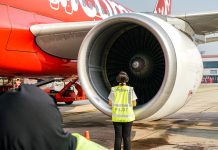Airport rankings
Best of the best
Every year since 2013, Singapore’s Changi Airport has been ranked as the number one airport in the world by the Skytrax Top 100 Airport Awards. Ten of the world’s top 20 airports are in Asia-Pacific, with four in Japan, which prompts the question are Asia’s airports really so far ahead of the pack? Michael Doran takes a look.
How can we get an objective view on the best airports in Asia-Pacific when there are so many factors, often unique to our own journey, that affect how we rate an airport? AAV has gone beyond a single ranking to look at how airports, particularly those in Asia, rate in four key areas – size and growth, service quality across multiple touch points, on-time performance and how happy passengers are with the airport experience.
Airport comparisons often begin with size and the Airports Council International (ACI) preliminary 2017 airport traffic rankings show the worlds 20 busiest airports grew by 5.2 percent with almost 1.5 billion passengers, or 17 percent of global passenger traffic, passing through their terminals. The busiest globally was Atlanta Hartsfield in the US while in Asia it was Beijing Capital with 95.8 million followed by Tokyo Haneda at 85.4 million and Hong Kong with 72.7 million. Asian airports filled nine of the top 20 spots.
According to ACI, the fastest-growing airport in Asia-Pacific is Delhi, which grew by 14.1 percent leading to the ACI comment: “With an astounding population base of over 1.3 billion inhabitants, the move towards a more liberalised aviation market coupled with stronger economic fundamentals has helped awaken the Bengal Tiger to become one of the fastest-growing markets in the world.” ACI predicts that the country will represent the third-largest aviation market by passenger throughput after the US and China by 2020. While not in the top 20 rankings, Calcutta at 27 percent, Hyderabad 20 percent and Bangalore at 13 percent also ranked among the fastest-growing airports in the world.
Aviation’s centre of gravity continues to shift eastward to China which boasts more than 10 airports with over 20 million passengers annually. Guangzhou is the third-busiest airport in China after Beijing and Shanghai Pudong with just under 66 million passengers growing by 10.3 percent in 2017. Domestic traffic continues to grow steadily and airports reporting double digit growth were Hangzhou, Xi’An, Nanjing and Tianjin.
Focusing on international traffic, Dubai leads the way ahead of London Heathrow, Hong Kong and Amsterdam Schiphol. Asian airlines fill seven of the top 20 slots led by Hong Kong, Singapore Changi and Seoul Incheon. The fastest-growing Asian airport for international traffic in the top 20 was Kuala Lumpur International, increasing traffic by close to 15 percent with Bangkok Suvarnabhumi next with 8 percent growth.
The process of ranking airports qualitatively is not so clear-cut with rankings relying on surveys, opinions and differing criteria to compile their tables. One set of rankings comes from air-transport consultancy Skytrax, which, since 1999, has produced its listing of the Top 100 Airports. This year it based its listings on 13.7 million survey questionnaires completed by over 100 nationalities of airline customers at 550 airports. Skytrax build its rankings from passenger experiences encompassing check-in, arrivals, transfers, shopping, security, immigration through to the departure gate.
In the last six years only five different airports have made it into the top three places and only two of those, Schiphol and Munich are located outside Asia. Since taking the number one spot from Incheon in 2013, Changi has held the crown for the last six years with Incheon in second place for five of those years and Haneda for the other. In any sphere being number one for six consecutive years is quite an achievement, so what is it that puts Changi so far ahead of its rivals?
To find out, Asian Aviation asked Ivan Tan, group senior vice president for corporate and marketing communications, who said: “What is at the heart of the airport’s success is the Changi Experience, a combination of efficient operations, world-class facilities, excellent customer service with warm hospitality and anticipating a traveller’s needs before they even tell us what they want.”
Changi has put a focus on assisting passengers who may need help rather than relying only on a customer service desk. It has Changi Experience Agents in the terminals looking for people to assist with any enquires or requests, which in turn helps the airport stay attuned to what their customers actually need from them. “Without the human touch an airport will be just another cold interchange” Tan said.
Changi has always been a major Asian hub and to make connections an easy and pain-free process the airport has put in place the Fast and Seamless Travel (FAST) initiative, a suite of self-service options comprising self check-in, self bag drop, automated immigration clearance and self boarding with passengers able to check-in from home or at kiosks throughout the airport. In the new Terminal 4, opened in October 2017, facial recognition technology was introduced for the first time giving passengers the complete pathway of self-service options from home check-in to boarding the aircraft.
Perhaps a sign of why Changi is so successful is that despite winning the top ranking for the last six years, the airport shows no signs at all of sitting on its laurels but is building for a much bigger future. Tan said: “We are extremely honoured to be named Skytrax World Best Airport for the sixth consecutive year and this spurs us on to continue to deliver the best passenger experience for all who travel through Changi Airport. Last year we successfully opened Terminal 4 and upgraded parts of Terminal 1 and we are currently pursuing several projects to develop Changi Airport for long-term success.”
One of those projects is The Jewel at Changi Airport, due to open in 2019, described as an iconic mixed-use complex, featuring a stunning glass and steel facade with five levels of lush greenery and an indoor waterfall, a further five levels of retail, food and beverage below ground directly connected to terminals 1, 2 and 3. “When open it will be an icon not only in Singapore, but we hope of the region too” Tan added.
In 2017 Changi moved 62.2 million passengers but with advanced plans for building Terminal 5 and the construction of a third runway it will more than double in size to have the capacity for 135 million passenger movements per year, which on current figures would make it the largest airport in the world.
Skytrax also used the data collected to provide rankings on 15 other airport experiences, with many of these rankings dominated by Asian airports. If cleanliness is vital to a passenger then Haneda is the place to head for but you will also feel cleansed at Nagoya, Incheon, Taoyuan and Changi. Interestingly the same five airports head the table for the world’s best airport staff service.
The best place for collecting your luggage is Kansai International, to get through security is Tokyo Narita, transiting is best done through Hong Kong and the worlds best airport terminal is London Heathrow T2. Those on a leisurely trip will find immigration easiest at Taiwan Taoyuan and Centrair Nagoya; the best shopping at Heathrow, Changi and Hong Kong; the best fun is to be had at Changi followed by the world’s best airport food at Hong Kong. For those travelling domestically, Haneda, Shanghai Hongqiao and Tianjin were the popular choices and if you are on a budget then the best LCC terminals are Kansai, Narita and Melbourne T4.
Looking across Asia-Pacific, airport passengers voted Mumbai Chhatapati as the best in India, Sydney Kingsford Smith in Australia-Pacific, Changi in Asia and the best airport staff in India can be found at Delhi International and in China at Chengdu International. Rankings for any airport voted as the worst at anything were not available but the most improved airport award went to Rome Fiumicino.
ACI also produces a set of rankings entitled Airport Service Quality (ASQ) Awards, and in 2017 over 3.8 billion passengers passed through an ASQ airport. These awards are based on customer responses to recognise the achievements of airports of different sizes and regions by measuring passenger views on 34 criteria, including airport access, check-in, security screening, restrooms, retail and restaurants.
Speaking about the value of these awards, Angela Gittens, director general ACI World, said: “Objective measurement and benchmarking are critical in driving performance in any business, especially in such a competitive and dynamic one as an airport. These winning airports have dedicated themselves to delivering a stellar customer experience.” Awards are made by region and size so in Asia-Pacific there are six winners ranging in size from under 2 million passengers to over 40 million, with the winners in order of ascending size being Indore, Lucknow, Hyderabad, Denpasar, Chongqing and Mumbai. The award for the most improved airport in Asia-Pacific went to Ahmedabad.
In a statement, ACI said: “This year an unprecedented 16 airports are first-time winners, challenging best-in-class airports in the delivery of top quality customer service. This phenomenon reflects the increasingly competitive airport industry operating environment.”
Airports that provide great passenger experiences and quick connections are at the top of service rankings but to many business travellers on-time performance is the thing that really matters. While on-time performance may be determined by factors often out of an airport’s control, aviation consultancy OAG does compile On-Time Performance (OTP) tables that are sub-divided by the number of departing seats at individual airports.
There are five categories, ranging from Small (2.5-5 million) up to Mega at 30+ million departing seats per annum with OTP defined as flights operating under 15 minutes of the scheduled time. For the small category OTP was 85.5 percent falling in an almost linear trend back to 76.6 percent at the mega end of the scale. Focusing on the Mega Airports, OAG analysis showed the most punctual airport was Haneda at 86.75 percent OTP, followed by Madrid (83.6) and Atlanta, which although being the busiest airport in the world was still able to maintain OTP at 82.4 percent.
While Asian airports dominate most of the qualitative rankings, the region does not perform to the same level with on-time performance. In the Mega Airport category Haneda topped the rankings with Changi the next best Asian airport at six followed by Bangkok (16), Delhi (18), Hong Kong (19) and Incheon (20). Overall, Asian airports accounted for only 18 percent of the top 20 positions across all five categories, although Japan’s Osaka claimed top spot and Sapporo third in the 15-20 million seats per annum rankings. OAG also provide analysis on both international and domestic top 20 city pairs and these figures give some insights into where Asian OTP falls well below acceptable levels, such as Beijing to Shenzhen which can only manage to operate on-time at 50 percent and Mumbai to Delhi at 59 percent.


















Interesting blog, it reminds me of Narita Airport , Look at the excitement on the face most of the travelers, the cool frequent travelers, the worried face of the late travelers.
I tried to write a blog about it, hope you also like it in https://stenote.blogspot.com/2021/08/narita-at-airport.html